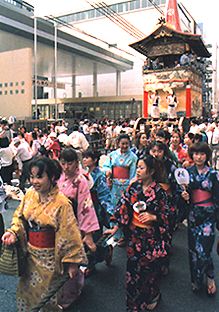WHAT'S COOL IN JAPAN July-September 1999 |
|
Yukata
|
 The kimono is the traditional dress of Japan and comes in many different varieties, including those for daily wear, formal occasions, and going out on the town. Today, though, except for the silk kimono known as tome-sode that is worn for formal social events and special ceremonies, this form of dress is hardly ever worn in daily life. This is due to the fact that compared to Western-style clothing the kimono is expensive and quite a hassle to put on. The yukata, however, is an exception.
The kimono is the traditional dress of Japan and comes in many different varieties, including those for daily wear, formal occasions, and going out on the town. Today, though, except for the silk kimono known as tome-sode that is worn for formal social events and special ceremonies, this form of dress is hardly ever worn in daily life. This is due to the fact that compared to Western-style clothing the kimono is expensive and quite a hassle to put on. The yukata, however, is an exception.
Most kimonos are lined and must be worn with one or more undergarments, but the yukata is a single-layered garment made from cotton that can be worn directly over the skin; it's perfect for just after a bath. It's also easy to wear. After slipping it on, make sure the left side is folded over the right side, then tie it with an obi (sash). Yukata are versatile, too, as they can be worn when stepping outside for a moment and even as pajamas, and they're ideal for Japan's humid summers. From early times Japanese have worn yukata together with geta (Japanese-style sandals) out to events like Bon dancing, fireworks displays, and festivals. Yukata were originally intended to be worn in the home and are designed simply. They traditionally come in white and dark blue, but beginning about 15 years ago yukata with a Western flavor in colors like black and deep green came into fashion. These soon became popular with young women, who began wearing them as fashionable outdoor wear. New lines of yukata by famous fashion designers like Kansai Yamamoto and Junko Koshino further spurred the popularity of this type of dress. Today, base hues include bright primary colors, beige, orange, pink, and black--all a far cry from the yukata styles of the past. And in addition to traditional geometric and cross-stripe patterns, designs featuring Western flowers, fruits, and even animals have become popular. Yukata fashion shows are now held in such places as department stores. Along with the popularity of the yukata, a wide range of accessories, such as matching obi, easy-to-wear geta, stylish ornamental hairpins, fans, and bags and wallets made from kimono sash cloth, have appeared on the market. This rich lineup allows the wearer to enjoy mixing and matching styles to fit a variety of occasions, from summer festivals and fireworks displays to sporting events and picnics. Today the yukata has become a fixed summer fashion. Because it was originally meant for home wearing, particularly after a bath, you'll also find yukata laid out for visitors in the rooms of many of Japan's hotels and ryokan (traditional inns). After bathing visitors can relax in their yukata and then wear them to bed as well.
Photo: Young women in colorful yukata parade through the streets of Kyoto during an annual festival. (Kyodo) |
 |